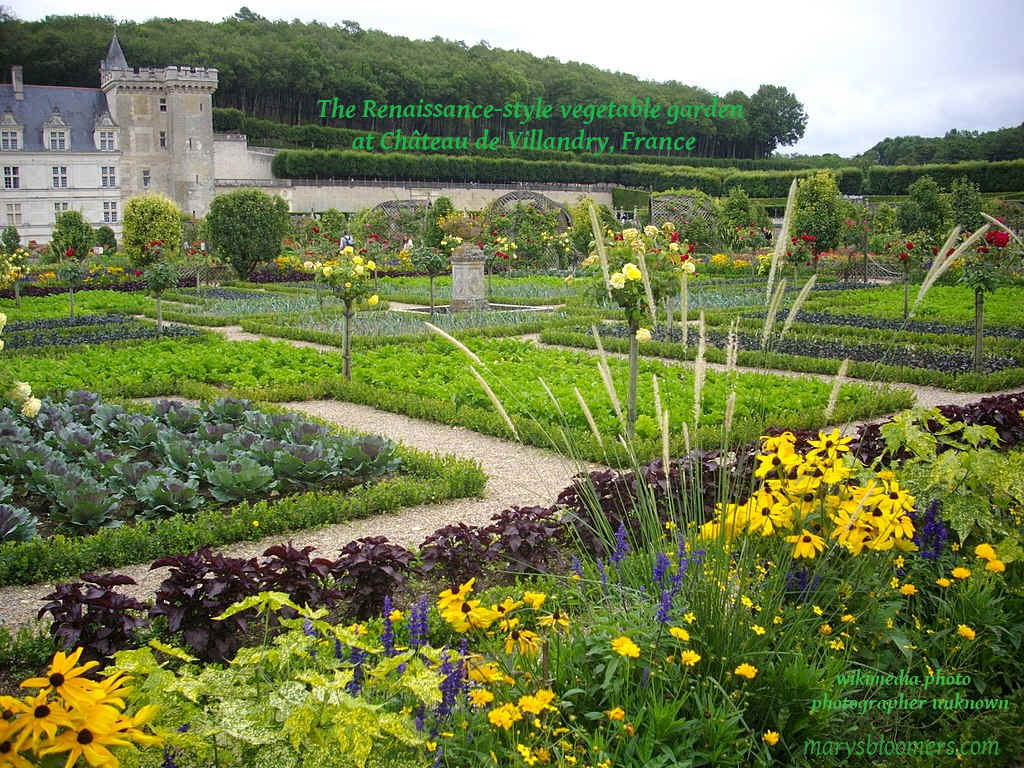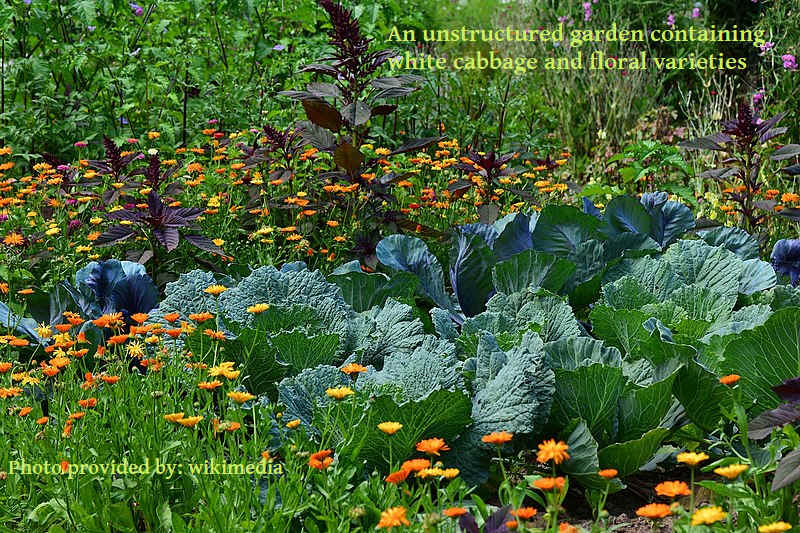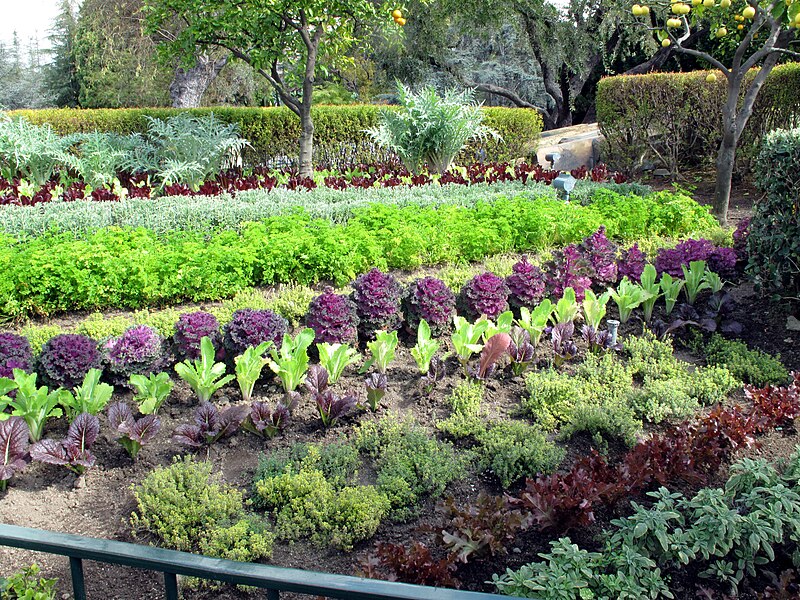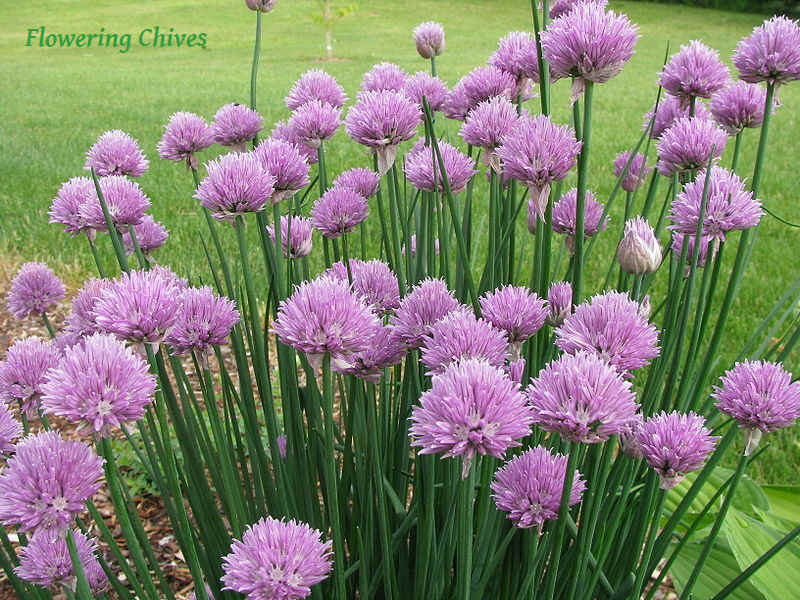Designing a Foodscape Garden
A Foodscape Garden combines
growing vegetables intermingled with flower plants.
It's a fairly new concept in the U.S., but has been done for centuries in France
and other parts of Europe.
 |
||||||||||||||||||||
|
The Renaissance-style
vegetable garden at Chβteau de Villandry, France, displays rows of
cabbage, I like growing bush beans and herbs between my taller flower plants. This concept is similar to companion planting, in that it makes every inch of the garden perform and produce something came to be, not because of high food prices, but wit the rise in urbanization, and increasing concerns for environmental sustainability. Urban Gardens and farming (patios, balconies, terraces, in containers and indoors) has it's own bonuses and contribute to sustainability by allowing the ability to grow vegetables, herbs, fruit and flowers all together, in small spaces. Foodscape Gardens are also referred to as "edible landscaping", and has been described as a cross between landscaping and farming. Foodscaping aims to show that edible plants are not only consumable, but can also be appreciated for their aesthetic qualities. Foodscaping spaces are seen as multi-functional landscapes, which are visually attractive, and also provide edible returns. Differing from conventional vegetable gardening, where fruits and vegetables are typically grown in separate, enclosed areas, foodscaping incorporates edible plants as a major element of a pre-existing landscaping space. This may involve adding edibles to an existing ornamental garden, or entirely replacing the traditional, non-edible plants with food-yielding species. The designs can incorporate various kinds of vegetables, fruit trees, berry bushes, edible flowers, and herbs, along with purely ornamental species of plants. The design strategy of foodscaping has many benefits, including increasing food security, improving the growing of nutritious food and promoting sustainable living
Unlike most historical horticultural practices, foodscaping explicitly supports the idea that edible landscapes can be just as aesthetically pleasing as purely decorative landscapes. Foodscaping advocates attempt to debunk the conventional perception of vegetable gardens as unattractive, and instead view edible crops as design features in and of themselves.
Edible garden design at
Pixie Hollow Garden, Epcot, Disney World Florida,
Edible landscaping techniques that were practiced in different historical cultures and periods can be seen as ancestors of foodscaping. In Ancient Rome, Roman villa gardens were often both productive and ornamental, though agricultural production was the primary purpose of earlier villa gardens. Archaeological research suggests that these Roman gardens took on various forms, such as large vineyard landscapes or small herb gardens. Kitchen gardens, vineyards and orchards played an important role in the lives of ancient Romans, whose diets were largely based on fruits and vegetables. In Mesoamerican culture, elaborate gardens and horticultural gardens were a pleasure of Aztec elites] Flowering, fragrant and medicinal plants were believed to be "perquisites of the lords". According to historical letters written by Aztec nobles, impressive gardens often included bright flower beds, fruit trees, herbs and sweet-smelling flowers. Groves, orchards and water gardens were sometimes incorporated into the designs of the more elaborate gardens. Another ancient precedent to Foodscape Gardens can be found in Mesopotamia. Babylonians and Assyrians created gardens throughout cities and in palace courtyards that were a representation of Paradise. These featured fragrant trees and edible fruits. Archaeological evidence suggests that Assyrian Kings developed a naturalistic landscape style in which streams of water ran through gardens that grew plants such as junipers, almonds, dates, rosewood, quince, fir pomegranate and oak. During the Renaissance, villa and chateau gardens in Europe often yielded fruit and vegetables to sell locally. The profits were used to support maintenance costs of the villa or chateau. Some of the common kinds of plants integrated into the elaborate Renaissance garden designs included figs, pears, apples, strawberries, cabbage, leeks, onions, and peas. It is believed that English cottage gardens were originally created by village workers during Elizabethan times as a personal source of vegetables. Flowers were also planted within these gardens for ornamental purposes.
The Ornamental Kitchen Garden is an edible landscape on the grounds of the chβteau of Villandry, located in the Loire Valley region of France. The Italian Renaissance-style garden is composed of nine square patches, which each feature a geometric design of flowers and vegetables whose design layouts changes with each bi-annual planting. These patches are lined with neat box hedges and each display vegetables of different colours such red cabbage, beetroot and blue leek. Each year, forty species of vegetables within eight plant families are planted.
Food SecurityFoodscaping is widely accepted as a way of increasing food security, availability and accessibility. The instability of supermarket food prices can largely affect the availability of food. As "self-sufficient food systems", edible landscapes are able to help decrease a household's dependence on imported food. Foodscaping provides these households with access to a sustainable food source, even when faced with unpredictable circumstances such as the inability to procure food from commercial stores or periods of low financial income. In increasing the quantity of locally grown and consumed produce, foodscaping also promotes local food sustainability. Energy SavingLarge-scale agricultural premises typically require large amounts of energy, such as the use of diesel, propane and electricity in order to carry out farming operations. The practice of edible landscaping often uses less energy and produces less waste than traditional methods of food production. This is because the food products cultivated from edible landscaping usually involve little processing, packaging or refrigeration. Plants and PlanningPlants in foodscaping designs are typically chosen for their aesthetic and edible appeal. There are many vegetables which can add color to foodscaping spaces. Swiss chard, cabbage and lettuce species come in many colourful varieties, making them a popular choice for foodscaping. Edible flowers, such as carnations, marigolds, cornflowers and pansies can also be used to add decoration and brightness to an edible landscape. Edible landscapes generally consist of a
combination of annual and perennial plants.
|
||||||||||||||||||||
|
Page
about French Garden Design is here Article is a compilation of
information from |
Very
Detailed
Site Directory--->
Send
fan mail to Mary's Bloomers-->
Quick Links
Content,
photos, graphics and designs©2020 marysbloomers.com
All rights reserved




